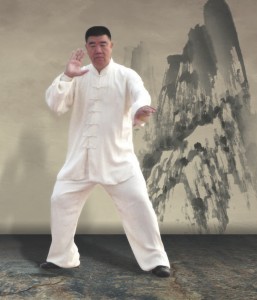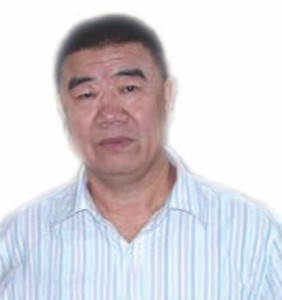By Sun Yongtian, as told to Dave Barrett
Translated by Mui Gek Chan
 I was born in 1948. Since my youth, I was always interested in the martial arts. I practiced many types of martial arts, including long fist and tang fist. In the 1970’s, I was successful in many of the martial arts competitions I entered. In May of 1982, under the recommendation of Zhang Yongan, I met my teacher Sun Jianyun for the first time. Frankly speaking, although I had learned martial arts since I was young, I had no knowledge of Taijiquan.
I was born in 1948. Since my youth, I was always interested in the martial arts. I practiced many types of martial arts, including long fist and tang fist. In the 1970’s, I was successful in many of the martial arts competitions I entered. In May of 1982, under the recommendation of Zhang Yongan, I met my teacher Sun Jianyun for the first time. Frankly speaking, although I had learned martial arts since I was young, I had no knowledge of Taijiquan.
When I first met Sun Jianyun, we hit it off just like old friends. She vividly described the history of Sun style Taijiquan – how her father Sun Lutang (1861-1932), developed Sun style Taijiquan, and many exciting stories about his skills. For example, “A famous Japanese martial artist was so determined to test Sun’s skills that he convinced the Emperor of Japan to send him to China to fight Sun. In 1921, the Japanese martial artist came to visit Sun and, speaking through an interpreter said, ‘I heard that you practice a Chinese martial art method which uses soft to overcome hard. Well, I am hard! How do you want to fight me? I will fight with any rules or any weapons.’ Sun turned to the interpreter and said, ‘Since he is a guest in our country, I will let him decide.’ The Japanese challenger said, ‘I am going to use hard strength to take your arm in a lock and break it. Let’s see if you can use your soft energy to overcome that!’ Sun, who at 5’7” barely came to the Japanese man’s shoulder, was willing to give it a try. Concerned that Sun could simply move his feet and get away from the lock the challenger said, ‘I want you to overcome this technique without running around.’ Sun said, ‘I can accommodate you.’ Sun had the spectators move all of the furniture aside and cleared a space on the floor. He said, ‘I will lie on the floor, your students can hold my feet, and you can apply your technique. I’ll even put my other arm behind my back.’ Sun laid on the floor and the Japanese martial artist took hold of his arm. The interpreter counted, ‘One, two, three!’ At the count of three Sun quickly pulled his free arm from behind his back and applied a point strike to his opponent’s stomach. This point strike caused the Japanese challenger to lose his grip on Sun’s other arm and Sun hopped up. The opponent was not so easily put off and followed Sun. Sun struck a few points on his opponent’s body and threw him into a bookcase. The interpreter shouted, “You’ve hurt him!’ Sun said, ‘He’ll be all right. Tell him when he catches his breath we can try it again.’ His opponent, admitting defeat, refused to try again.” 1 This was something I had not known and Taijiquan became deeply ingrained in me.
From then on, Sun style Taijiquan became a part of my life and changed the way I value life.
Sun Lutang’s daughter, Sun Jianyun was born in Beijing, in 1914. Their ancestral home was in Wangdu, Hebei Province. She was a famous martial arts expert in China, lineage bearer and 2nd generation decendant of Sun style Taijiquan, one of China’s top ten martial arts masters, vice-chairman of Beijing Wushu Association, director of Beijing Xingyiquan Institute, and director of Beijing Sun Style Taijiquan Institute. When Sun Jianyun was young, she received tutelage at home, was skilled both intellectually and in the martial arts, and deeply understood the essence of Xingyi, Bagua, and Taijiquan. In her youth, she studied calligraphy and wrote poetry. Later, she went to Beiping Huabei Arts Academy and studied Chinese painting, specializing in landscapes and portraits of women. She had exquisite brush techniques and was then one of the top four up and coming artists.
 As I gained more exposure and understanding, along with Teacher Sun’s magnetic personality, I found myself drawn to Taijiquan. Teacher Sun had a wide and deep knowledge, an open mind, great inner qualities and a high level of martial arts skill. Teacher Sun had great character and virtue, and taught us how to practice martial arts in society. That is, being morally upright and righteous. She often encouraged us to practice the form, cultivate our health and to have an open mind.
As I gained more exposure and understanding, along with Teacher Sun’s magnetic personality, I found myself drawn to Taijiquan. Teacher Sun had a wide and deep knowledge, an open mind, great inner qualities and a high level of martial arts skill. Teacher Sun had great character and virtue, and taught us how to practice martial arts in society. That is, being morally upright and righteous. She often encouraged us to practice the form, cultivate our health and to have an open mind.
I was deeply affected by her words and manner, and as a result, I diligently studied Taijiquan so as to continue and spread Sun style Taijiquan. At the same time, at work as well as in my social life, it also affected the people around me.
Sun Lutang created his style by combining Xingyi, Bagua, and Taijiquan into a unique martial art. It is one of the five main styles of Taijiquan in China, namely, Chen, Yang, Sun, Wu, and Wu/Hao. Sun Lutang learned Taijiquan from Hao Weizhen. Sun was able to attain a high level of skill, and achieved a deep understanding. Under Hao Weizhen’s tutelage, Sun Lutang was able to master the essence of Wu/Hao style Taijiquan. As a result, he developed the three-in-one, Sun style Taijiquan. He combined features from the two other “internal” martial arts styles: utilizing Xingyiquan’s approach of combining internal and external into one and Baguaquan’s emphasis on combining movement and stillness into one to create his style of Taijiquan.
Sun style features a high stance and is a lively, open/close Taijiquan, with a lot of movements and many self-defense mechanisms. The foot work advances and retreats naturally, the torso position is upright, the best angle for learning purposes, and is easy on the knees. Sun style is like moving clouds and flowing water, continuous without interruption, advancing and retreating connected, the movements are agile, circular, lively and compact. When advancing or retreating, every turn of the body has an opening/closing method that is connected. In addition, it is good for health purposes. As a result, Sun style, along with the other methods of Taijiquan, is known to the Chinese people as being beneficial for health and longevity, good for the young as well as the old.
In Sun style Taijiquan, whether advancing or retreating, the body needs to be centered, head suspended, chest loosened, and at all times one must be calm, comfortable, and relaxed. Like flowing water and falling leaves, the motions need to be flowing and coordinated. When moving, there is no bobbing up and down, or swaying left and right, but, with lively steps causing the center to be continuously stable and yet be in motion. One must pay attention to the merging of the three: Xingyi, Bagua, and Taijiquan. However, the forms must originate from Taijiquan’s special qualities, as we do not show the specific energies of Xingyi and Bagua’s movements. To show Sun style Taijiquan’s flavor, the movements need to be accurate, relaxed, supple, connected, and the mind needs to be calm. In 1993, at the martial arts conference held at the Beijing Xijiao Longquan Hotel, Wu Bin, president of the Beijing Wushu Institute, suggested to Teacher Sun that she look for a successor. Later, Teacher Sun told me that she wanted me to be the lineage bearer and 3rd generation exemplar of Sun style Taijiquan. I was deeply moved by her gesture, but was hesitant to accept the offer. But, after two years with no one raising any objections, I reluctantly accepted the honor. From that point on, I have worked tirelessly to continue and promote Sun style Taijiquan.
Unfortunately, in October of 2003, Teacher Sun Jianyun passed away. She left a will stating that Sun Yongtian (same last name, but of different family) is the sole successor to her. Witnesses to her will included her cousin, Zhang Wenyi, disciples: Dai Jianying, Zhang Maoqing, and her brother’s granddaughter, Sun Qi. ☯
(Sun Yongtian is chairman of the board of a state-owned
automotive sales and service company. He is the
vice-chairman of Beijing Wushu Association, and the
director of the Sun Style Taijiquan Research Institute.)
1 Sun, Lutang, A Study of Taijiquan, translated by Tim Cartmell,
Berkley ,Ca., North Atlantic Books 2003, pgs.29-30
Reprinted from Journal 25, Tenth Anniversary Issue, Summer 2009
